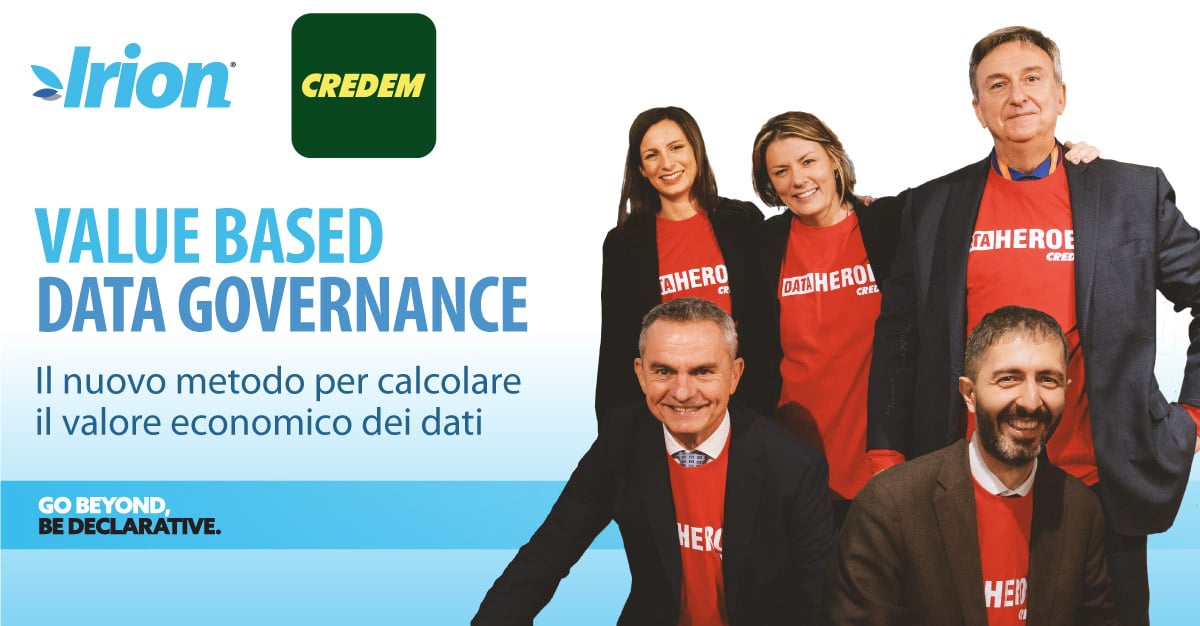The described concrete formula calculates the economic value of data governance initiatives according to two dimensions. The first one concerns the monetary impact of individual Data Governance projects, while the second one considers the economic benefits of the entire corporate data asset governance program. For instance, it is possible to determine the percentual impact of all these activities on individual company balance sheet items, from staff costs to interest margin to IT expenditure.
It is the cornerstone of the new Value Based Data Governance method developed in collaboration between CREDEM Bank (CDO Stefano Zoni and Information Governor Elena Testoni), Irion (Principal Advisor Mauro Tuvo and Head of Marketing Egle Romagnolli) and Franco Francia, consultant and professor of Performance Management Systems at the University of Modena and Reggio-Emilia. The paper is available for download at the link above. It aims at giving practical application to the scientific and managerial thoughts on Data Valuation, the discipline that valuates corporate data assets, five years after the publication of Douglas Laney’s Infonomics.
What are the benefits of Value-Based Data Governance?
The authors have described the new approach at the major events of the Italian data community. Their intense roadshow included the DAMA Italy convention, the ABI Lab IT Evolution event, and the Big Data and Business Analytics Observatory of Politecnico di Milano. On all these occasions, they appealed to making a system to value the work of the Italian leaders in data, inviting everyone interested to try out the Value-Based Data Governance method within their organization.
“If people do not pay attention to these processes and do not support them with appropriate competencies, I can have everything implemented, but it will not give me value. What is the evolutionary purpose? This is what must make us move: providing a service to people,” emphasizes Stefano Zoni. In essence, a Data-driven Organization needs “a widespread data culture in support. We can do the most beautiful things in the world, but doing them is useless if people don’t understand them; in fact, they would be just an expense,” CREDEM Chief Data & Analytics Officer explains. The model must be effective, proactive, timely, and sustainable.
“We had different points of view: a bank, a vendor, and a consultant and university professor. It’s been an arduous but exciting challenge,” says Egle Romagnolli. “If, for example, in my master plan, I have ten data management projects, with this method I can set the priorities and figure out which one to start with. I need practical tools to have discussions with the management. Then I will be able to say that, to augment the value of corporate data assets, I will need to do exactly this many projects, already ordered by the profitability for the company.” So how exactly is the economic value of the activities aimed at improving data asset management quantified? And what benefits does adherence to the model bring?
Project evaluation: the two phases of valuation
In the first phase of a project evaluation, the model suggests configuring the drivers that may influence the increase of data asset value, determining the use cases, and, crucially, estimating the contribution the data items can give to balance sheet items. “We estimated the percentual impact on balance sheet items such as staff costs, interest margin, or IT expenses. I produce value if there is a connection to a concrete monetary value within the company,” Romagnolli notes.
The second phase uses a risk-based approach to detect the risks that may impact the value of the data. For example, if a bank’s marketing department wants to send a DEM to all potential customers on a new product, what is the value of such an email if only 30% of the addresses are of good quality? And to what extent can, for instance, my data quality activities mitigate this risk? Thus, the project value is a result of a mathematical formula that considers the value of data in the perimeter, the inherent risk, and how much can be contained due to the actions on the data involved.
Program evaluation: five levels of maturity
How to calculate the return on investment (ROI) in Data Governance? The model calls for considering all DG action perspectives and estimating the impact on balance sheet items for each. The program’s value will thus be the sum of the impacts of the various DG perspectives on business items. “The easier it is to calculate the cost reduction, the more complicated it is to determine the revenue increase,” Francia emphasizes.
The formula calculates the target value (“The Holy Grail every data professional seeks”), i.e., the theoretical value that could be obtained if it were possible to immediately implement with some magic wand all the components on the entire corporate data assets. How is it then possible to manage and scale it in practice? By applying a classification system borrowed from the Capability Maturity Model. The paper mentions five Waves, or levels of maturity.
For example, if the DG value for Wave 1 is considered equal to 106,000 euro, this sum becomes 1.2 million at the second level, 9 million for Wave 3, 13 million for Wave 4, and 18 million for Wave 5. The value depends on the DG aspects activated at each maturity stage. The eight Data Governance perspectives considered in the model applied in CREDEM are the following:
- Data Quality
- Horizontal Physical Lineage
- Horizontal Business Lineage
- Vertical Lineage
- Data Taxonomy
- CIA (Confidentiality, Integrity, and Availability) Taxonomy
- GDPR Taxonomy
- Process Taxonomy
The future: making a system to give value to the data leaders
“Everything we do must aim at satisfying a need. The activity is based on CREDEM data. Franco’s, Mauro’s, and Egle’s experience allowed us to adjust the method so that it takes root. Our purpose is not to stop there, but to create a system with other organizations and thus evolve the method towards a model that can be of use for all data professionals and enhance their work, which is not always fully understood in the company,” highlights Stefano Zoni.
Some insurance companies and fashion brands are also interested in the emerging working group: “It is not simple to describe the entire value, the sustainability, and the evolutionary approach behind this model, – emphasizes Mauro Tuvo. – But we are there for anyone who wants to learn more, collect experiences, and return value to colleagues. We will be able to improve various elements, such as driver calibration, formulas, applicability areas.
The more use cases are shared, the more advanced will the model become. For example, it will be possible to use different driver sets valid for other fields and industries outside of Finance.” To apply, write to valuebased@irion.it
Data quality and SMEs
As the paper explains, there are a number of reasons and expected benefits for which organizations may expect a significant ROI from Data Governance supervision. The accounting innovations coming up for small and medium-sized enterprises are a good example. “From 2023, SMEs will have to make a sustainability report, which from 2024 will have to be certified. For such activities, it is crucial to have quality data”, Franco Francia emphasized during the ABI Lab event. “It is also clear that in Data Management, different visions and approaches coexist, – the expert explains. – And that is another reason to create a standard approach and use a framework similar to the one the paper describes to create better value.”






